Introduction
[2] Galatians teaches us about justification by faith, but also—and this is my thesis—more about God’s calling Paul on mission to ethnic others than we have perceived. Precisely in Galatians, Paul also teaches us about God’s ethnic inclusion of emigrants,[1] about valuing all ethnicities.[2]
[3] First, I give a contemporary context to this reading of Galatians: Lutheran-Catholic dialogue relating justification and sanctification, remembering the contributions of Joseph Fitzmyer, a Roman Catholic scholar on the dialogue team. Second, I illuminate the political and especially the visual context of Paul’s own debate with his addressees, the Galatians, the Gauls. Third, I interpret the theological and ethical meaning of Gal 3.28 and Gal 5.16-26. Finally, I narrate how Prof. Ernst Käsemann lived his theology of salvation by faith in our Lord Jesus Christ while opposing Hitler and preaching to German Christians in his congregation.
Paul to the Galatians[3]: Justification by Faith and Crossing Ethnic Boundaries
[4] Luther lectured twice on Galatians, in 1519 and 1531. Galatians was his “dear epistle,” his “Katy von Bora.”[4] Galatians was a key source, of course, of Luther’s theology of justification by faith alone. The contemporary “Joint Declaration on the Doctrine of Justification” very carefully interprets justification. I quote from the section on “Sources for the Joint Declaration on the Doctrine of Justification” that supports section 4.3: “As Lutherans we maintain the distinction between justification and sanctification, of faith and works, which however implies no separation. Catholic doctrine knows itself to be at one with the Protestant concern in emphasizing that the renewal of the human being does not ‘contribute’ to justification, and is certainly not a contribution to which he would make any appeal before God. Nevertheless it feels compelled to stress the renewal of the human being through justifying grace, for the sake of acknowledging God’s newly creating power, although this renewal in faith, hope, and love is certainly nothing but a response to God’s unfathomable grace.” [5]
[5] This statement could be understood in an exclusively individualistic sense. The quotation refers, e.g., to “the human being” and to “he” in the singular and the masculine. As Lutheran I both affirm the theology of that paragraph for individuals (male and female), and want to argue that we can learn more from Paul’s letter to the Galatians about God and Paul crossing ethnic boundaries, about interethnic harmony and dialogue than we have typically realized.
[6] Joseph Fitzmyer and John Reumann, both New Testament scholars, wrote the first draft of the Joint Declaration. I express my utter admiration of Fitzmyer, for example, of the article “Justification by Faith in Pauline Thought: A Catholic View.” [6] The Jesuit Fitzmyer traces Paul’s affirmation of God’s righteousness in the face of Israel’s disobedience back to Deutero-Isaiah (56.1), Ezekiel (18.19, 21), and Qumran[7] (1QS 11.9-15; see 4QMMT = 4Q394-399). Fitzmyer’s command of Aramaic, Hebrew, and of New Testament Greek is unsurpassed, and he insists that Paul’s emphasis on God’s righteousness especially in Romans has roots in both in the biblical prophets and in contemporary Judaism. This affirmation would perhaps not be surprising in a Lutheran scholar like Reumann, but that a Catholic scholar affirmed it and participated in persuading his whole communion to agree is overwhelmingly impressive, surely another act of God’s grace to us all.
[7] The first section of Fitzmyer’s article treats the Old Testament; the third section interprets Romans and Galatians. Everything he writes about Romans and Galatians is, of course, debatable and has been contested at length, but I will not pause over these disputes. I proceed to my own thesis. As an example, I refer to the book The Galatians Debate,[8] which is introduced by the editor and contains 23 articles. The final article has the title, “Foolish Galatians?—a Recipient-Oriented Assessment of Paul’s Letter,” a fine article which begins with Gal 3.1, Ὦ ἀνόητοι Γαλάται! “O foolish Gauls!”
The Gauls / Galatians Visually Represented by Greeks and Romans
[8] Here is my point: not a single author in this book asks who the Galatians themselves were, the Gauls! The focus is exclusively on Paul’s theology, his conflict with Jewish and/or Jewish-Christian opponents. Please do not misunderstand me: the theology is crucial; in my Introductory courses on Paul and on the Gospels at Pacific Lutheran Theological Seminary, I typically ask students to read Udo Schnelle,[9] who always does both exegesis and Lutheran theology. But I object to focusing so exclusively on Paul and his theology that we fail to notice who his conversation partners were. The Galatians were more than generic “gentiles”! Let me show the Gauls to you, or rather, the visual representations of Gauls by Greeks and Romans.[10]
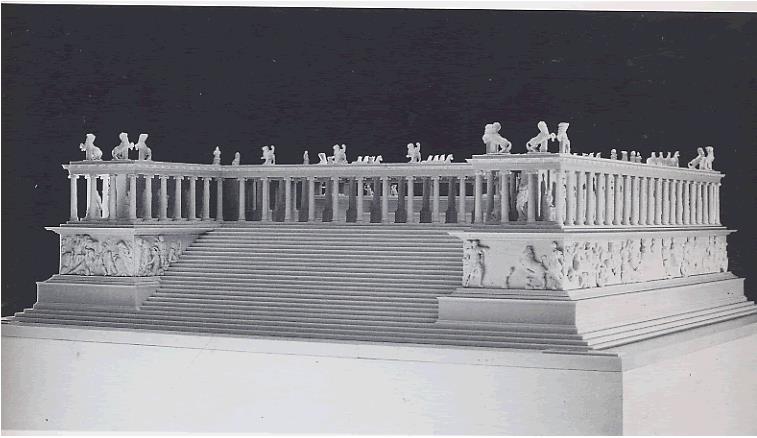
Fig. 1. The Pergamon Altar to Zeus (fig. 1) is 116.92 feet wide and 109.58 feet deep; the front stairway is c. 65.6 feet wide. The base is decorated in high relief with a frieze showing the battle between the Olympian gods and the Giants known as a Gigantomachy. It was built by King Eumenes II c. 165 BCE, an Altar now reconstructed in the Pergamon Museum in Berlin. I note that this altar was in Asia Minor the geographical region to which Paul wrote his epistle to the Galatians.[11]
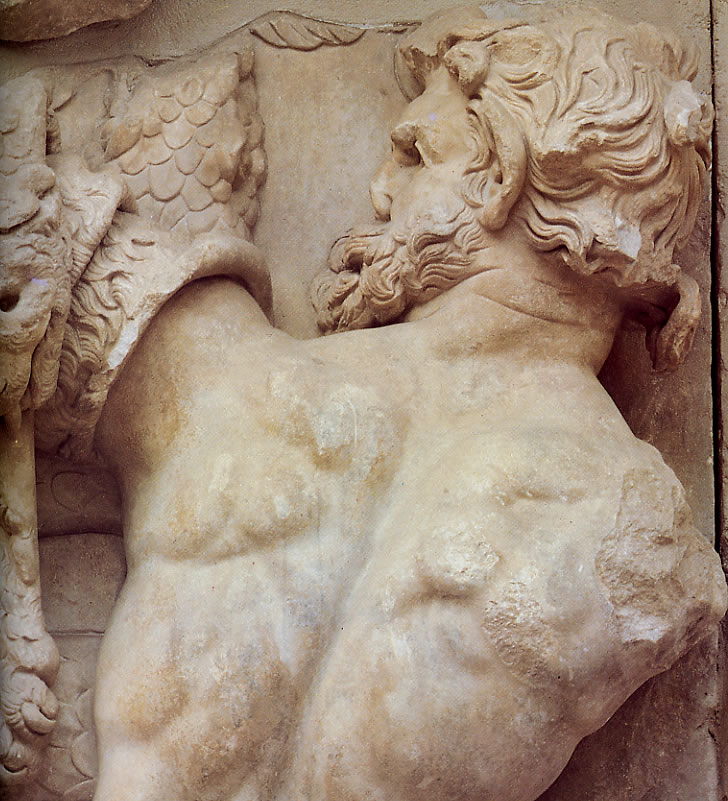
Fig. 2. Giant Klytios with reptile scales for an arm fights Hecate (not seen).
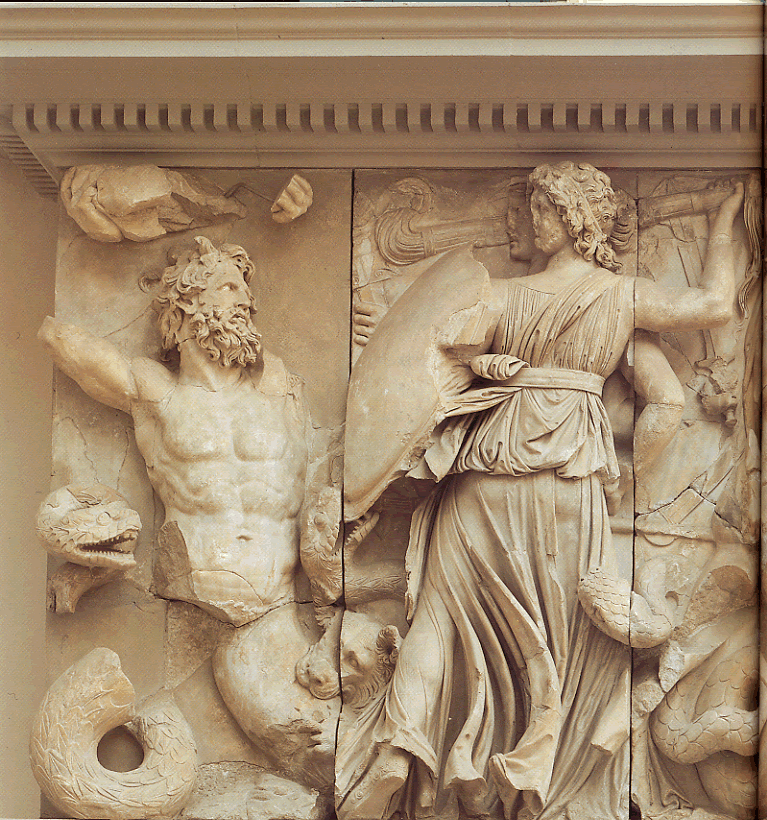
Fig. 3 Giant with snake legs fights goddess (fig. 3)
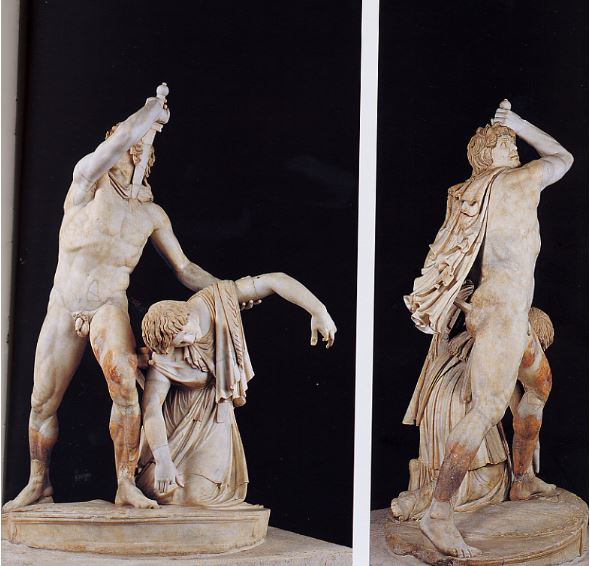
Fig. 4. Giant Gaul killing himself and his wife[12] (fig. 4; seen by Josephus[13] in Vespasian’s Temple of Peace in Rome, which Josephus mentions just before narrating Masada, the similar suicide of Jewish soldiers who had killed their wives), now in Palazzo Altemps, Rome.
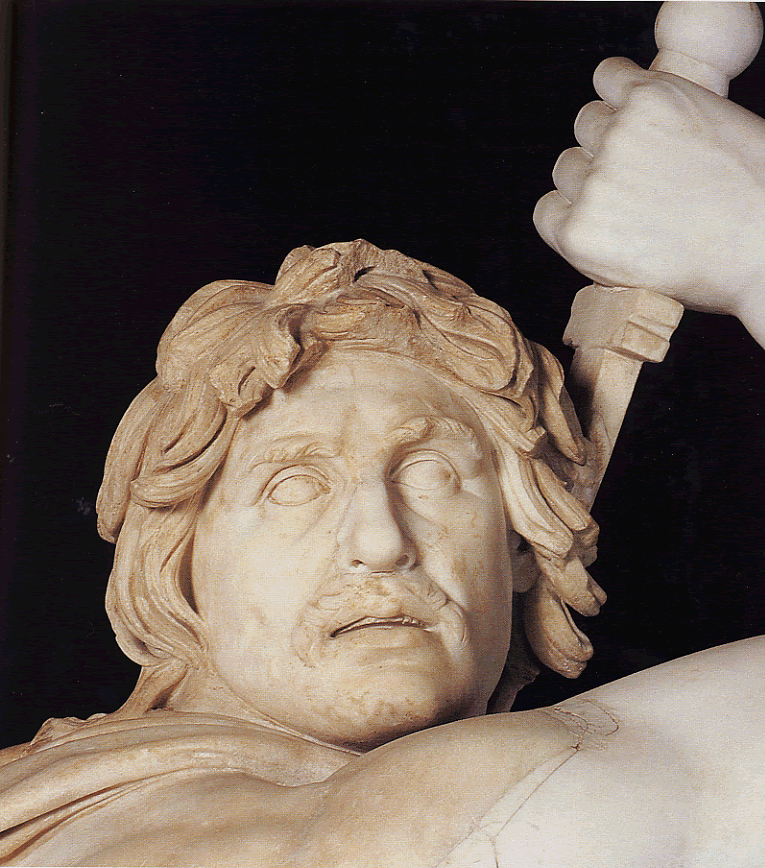
Fig. 5. Wild hair (fig. 5) of a Gaul killing himself (from fig. #4): “the Gauls are always washing [their hair] in limewater and they pull it back from the forehead … so that they look like Satyrs and Pans; for this treatment makes the hair so heavy and coarse that it differs not at all from horses’ manes ….” (Diodorus 5.28.21, trans. Oldfather in LCL)[14]
[9] In summary, in the frieze surrounding the Altar to Zeus in Pergamon, the beautiful, powerful gods and goddesses sculpted on top symbolize the Pergamene “Greeks,” while the defeated, dying, semi-human, snake-like animals on bottom symbolize the Gauls, those whom the Pergamene kings and Rome always defeat—to whom Paul wrote Galatians.
Greeks and Romans celebrating the defeat of dying Gauls—and Jews
[10] Now I survey the wide geographical areas in which these aesthetic monuments of the dying Gauls were displayed, monuments later than and often dependent on the baroque Altar of Zeus in Pergamon. I emphasize that these images were popular, not isolated on top of the mountain on which Pergamon was built. The only artistic monument we have from Ephesus from the 2nd century BCE is a relief celebrating the Pergamene defeat of the Gauls.[15] In the same time period a king in Pergamon sent an elaborate monument of 50 bronze statues to Greece, to Athens, which celebrated 1) the famous war of the gods against the Giants, 2) the Athenians against the Amazons, that is, two mythical battles, and also two historical battles, as follows: 3) the battle at Marathon of the Greeks against the Persians, as well as 4) the “Greek” Pergamene destruction of Gauls in Asia Minor (Pausanius 1.25.2). The great book by Andrew Stewart is on that Pergamene Dedication on the acropolis in Athens.[16] The dying Gauls were also sculpted by Greeks on the island of Delos.[17]
[11] When the Roman Octavian/Augustus built a Temple to Apollo connected to his own house on the Palatine hill in Rome, one of the two marble doors of the Temple exhibited a relief of Gauls defeated at Delphi.[18] Nero exhibited a statue of a giant Gaul killing himself and his wife (figs. # 4-5 above), in the central Octagonal Room of his Golden House in Rome,[19] and also in his villa at Anzio, a statue of an Amazon defeating a Gaul.[20] When Vespasian and Titus built the so-called Temple of Peace[21] in Rome to celebrate their victory in the Judean War, the statue from Pergamon of the Gaul killing himself and his wife (figs. # 4-5 above) represented the defeat and death of the Jews. Josephus mentions this Temple of Peace just before he narrates the suicides of the Jews at Masada.[22]
[12] In summary, Greeks in Pergamon and Ephesus in Asia Minor, on the island of Delos, and in Athens celebrated their victory over the Gauls by erecting monuments with statues of dying Gauls. Romans followed suit: Augustus in the most important temple in the empire, the one to Apollo adjacent to his house on the Palatine hill, and Nero both in his Golden House and in his villa in Anzio had the Gauls sculpted as the barbarians par excellence, nevertheless defeated and killed by Greek or Roman armies. Following Augustus and Nero, Vespasian also displayed a Gaul killing himself and his wife to represent and celebrate the defeat and deaths of the Jews/Judeans.
[13] The Gauls were invading emigrants from the north: they invaded Greece and Asia Minor in 279-78 BCE, attacking Delphi.[23] Julius Caesar’s war with the Gauls was in 58-52 BCE. In 49 CE Claudius expelled both Jews and Gallic Druids from Rome for riots (Suetonius, Claudius 25.4-5). And in 68 CE, the year of Nero’s suicide, there was a Gallic/German uprising against Rome under Civilis, heralding “the Empire of all Gaul.”
[14] I quote the art historian Stewart’s conclusion at the end of his 241-page monograph, which has 287 figures of these dying Gauls/barbarians: “The Little [Gallic] Barbarians’ [facial] expressions [displayed in Athens] show that they understand the end that imminently awaits them …. The Barbarians’ diverse reactions openly acknowledge … the victors’ power—for as Plato memorably put it, the power of anything is literally its power to hurt[24] (Philebos 49b-d) …. [The Little Gallic Barbarians] show that at some level they have internalized the victorious Other—Hellenism’s overwhelming moral and ethical superiority, its matchless virtue (arête). They have measured themselves against it and have found themselves fatally wanting. So we find a paradox: By thinking themselves through the victors in this instant of terminal self-revelation, these ‘mindless’ (aphrones) barbarians have come to a certain understanding … albeit only at the moment of death. Once repulsed from Delphi, they have finally arrived there in spirit and … now ‘know themselves’—their station and fate in life. They know that measured against the Greek, they know nothing and are nothing.”[25]
Paul, theology, and the Gauls—on Gal 3.28
[15] The gospel Paul preached to the Gauls opposed this Greco-Roman worldview, which for two centuries before Paul arrived in central Asia Minor, Greeks and Romans had militarily, politically, and visually thrust at the Gauls. We do not teach students in our classrooms in Lutheran colleges and seminaries as if their identity, their ethnicity for example, whether they are “white,” black, or brown, makes no difference! It is a mistake exclusively to analyze Paul’s theological critique of Mosaic law; it is another mistake exclusively to analyze the textual descriptions of the Gauls. The vast majority of people in the Greco-Roman world were visually oriented, not textually; that is, most could not read.
[16] Brigitte Kahl is correct: Gal 3.28, “there is no longer Jew or Greek,” not only denies that the Mosaic law of circumcision qualifies some and disqualifies others before God. In the larger cultural context, the “Greeks” mentioned in this baptismal formula claimed to be superior to the Asian, barbarian Gauls.
[17] Josephus also calls Israel “Asian” (Ant. 5.222), that is, Asian like the Gauls. In Gal 3.28 both Jews and Gauls are barbarians / Asians, and many would hear the baptismal formula assert: We Jews/Gauls/Asians are not inferior to “Greeks”! When Paul realized that God justifies us without law, that meant both without Mosaic Levitical law and also without Greco-Roman colonizing law that put Gauls and Jews in their place, in Andrew Stewart’s words, which meant that Asians, that is, Gauls and Jews, “know nothing and are nothing.” Paul was indeed surprised that the Gauls would fall from their belief that “there is no longer Jew—that is, there is no long Asian barbarian—and Greek,” that the Gauls would fall back into the Greco-Roman world view that they were socially and politically “nothing.” Paul’s gospel countered racism against emigrants in the Roman Empire. How do we understand this theologically?
Paul on God’s gifts (charismata) that are more than social ethics—on Gal 5.16-26
[18] My teacher (1968-1970), Ernst Käsemann in Tübingen, Germany, denied that Paul’s acts and mission could be understood simply as social ethics. “The concept of ethics stems from Hellenistic tradition, and is the basis of the modern idea of performance …. I cannot derive such a discipline from the Bible …. Pauline theology announces the justification of the godless [Rom 4.5], and in place of ‘ethics’ sets its doctrine of the charisms [see Gal 5.16-26], which in turn reflects the first commandment. God is the Lord who commands, but he is such as the one who delivers from Egypt and forbids giving his place to other lords and gods …. Now the recipient of charis [grace] becomes at the same time the bearer of charis and its being let loose in the world.” … The first commandment is truly a gospel. It calls to us to hand on what was given us, that is, the freedom of grace.”[26]
[19] Käsemann also makes the following crucial observation: “the sacramental gift [charisma] of the pneuma [Spirit—in baptism and in the Lord’s Supper] is not for the Apostle some heavenly power, which enters man [and woman] in some vague and impersonal manner. This gift brings with it its Giver; it is an epiphany of the exalted Lord, [27] who becomes manifest in it. Through it we are brought into his presence and thereafter, we stand ‘before his face.’[28] In the pneuma [Spirit], the Kyrios [Lord] comes to us, takes possession of us and claims us for his own.”[29] When God gives us faith, God does not abandon us to our own finite resources as we respond to God’s call, but God’s own self comes to us. Paul encourages the Gauls to live by and be guided by God’s Spirit (Gal 5.25).
[20] Käsemann did respond in his own life and ministry to the charis and the charism God gave him. We can read, for example the sermon he preached 15 Aug 1937 as pastor in Gelsenkirchen-Rotthausen. In his sermon he cited the supposedly new gospel (das neue Evangelium): “Germany is God’s chosen people, and the Führer God’s Messenger to our time.” And he cites some objections raised against him: His preaching was “not national enough, was too Jewish. Politics does not belong in the chancel.”[30] Three days after this sermon, the Gestapo arrested him and took him to prison.
[21] Paul, writing to the Gauls, and Käsemann as a Lutheran pastor in Nazi Germany proclaimed justification by faith alone, and they both also responded to the charis and the charism that God gave them, to the first commandment, proclaiming that there is no God but one. Neither the Roman Caesar, who makes emigrant Asian Gauls (and the Asian Jews) “nothing,” nor the German Kaiser, who murders Jews are divine or are to be obeyed.
CONCLUSIONS
[22] The Gauls to whom Paul preached and to whom he wrote Galatians were not generic Gentiles. Both Greeks and Romans represented these “Asians” as fierce, gigantic invading emigrants from the North, who nevertheless in relation to Greeks and Romans, were sub-human, snake-like animals, “nothing” (Stewart). Their lime-washed hair was one of the symbols of their physical and cultural otherness, as Paul’s Jewish circumcision was a symbol to Greeks and Romans of his otherness.[31] Paul preached the freedom of the gospel to them, and they were baptized hearing that, in contrast to both Roman colonial law and to Mosaic covenantal law, “there is no longer Jew or Greek” (Gal 3.28a).
[23] My teacher (1970-1974) at Yale, Nils Dahl,[32] observed that in Gal 4.12, Paul shifted for the first time to the imperative mood: “Friends, I beg you, become as I am, for I have also become as you are.” (NRSV) Paul had become one who lived like a Gentile (Gal 2.14; compare 1 Cor 9.21, “To those outside the law, I became as one outside the law ….”). We are “not justified by the works of the law, but through faith in Jesus Christ” (Gal 2.16). Living like a Gentile among Gauls, the Romans’ enemies, meant joining their famous pork banquets (Athenaeus, Deip. iv.154b[33]: see 1 Cor 10.25a: “eat whatever is sold in the meat market ….”). Paul the orthopraxic Jew had become as a Gaul.
[24] Paul also invites the Gauls to “become as I am” (Gal 4.12), no longer to believe the Greco-Roman, colonizing gospel of their own ethnic Asian inferiority, their “nothingness,” or as males to obey the Mosaic covenantal law and be circumcised. Like Abraham (Gal 3.8-9, 29), the Gauls had rejected both forms of ethnic and legal status differentiation, Greco-Roman and Mosaic/Levitical, when they repeated the ritual language of baptism (Gal 3.28a).
[25] Not surprisingly, as we see in Galatians 2:11-3:5 (and Acts 10-15), this denial of ethnic and legal inferiority generated serious religious/political conflict, just as does the proclamation in our North American present that “black lives matter.” Paul’s mission to the Gauls was an effort to convince Gauls that Gauls’ lives matter, a contrast to Greek and Roman values, who entertained themselves with public spectacles of the Gauls dying.
NOTES
[1] For migration in the Greek world see Robert Garland, Wandering Greeks: The Ancient Greek Diaspora from the Age of Homer to the Death of Alexander the Great (Princeton: Princeton University, 2014). For the patriarchs’ migration narrated in Genesis, see J. Van Seters, Changing Perspectives I: Studies in the History, Literature and Religion of Biblical Israel (London: equinox, 2011), chap. 15. Israel’s enemies, the Philistines, were also emigrants—Mycenaeans from Greece: J. Aruz et al, eds., Assyria to Iberia at the Dawn of the Classical Age (New York: Metropolitan Museum of Art, 2014), 42.
[2] Robert Jewett, Romans: A Commentary (Hermeneia; Minneapolis: Fortress, 2007), 131, argues a similar case for Paul’s proposed mission to Spain.
[3] On the meaning of ταῖς ἐκκλησίαις τῆς Γαλατίας (Gal 1.2b) and of Ὦ ἀνόητοι Γαλάται (Gal 3.1a) see Cilliers Breytenbach, Paulus und Barnabas in der Provinz Galatien: Studien zu Apostelgeschichte 13f.; 16,6; 18,23 und den Adressaten des Galaterbriefes (AGJU 38; Leiden: Brill, 1996), chap. V, 1.1-2, who argues that Paul addressed Galatians to the province (Gal 1.2b), where ethnic Gauls lived (Gal 3.1a). Peter Oakes, Galatians (Paideia; Grand Rapids: Baker, 2015), 18, argues against ethnic Gauls/Celts as addressees, but he undervalues the visual evidence presented below.
[4] Table Talk, Luther’s Works (1967), vol. 54, 20, cited by Brigitte Kahl, Galatians Re-imagined; Reading with the Eyes of the Vanquished (Minneapolis: Fortress, 2010), 11, n. 27.
[5] Joint Declaration on the Doctrine of Justification: English Language Edition (The Lutheran World Federation and the Roman Catholic Church; Grand Rapids: Eerdmans, 2000, from German of 1999), 33.
[6] Joseph A. Fitzmyer, S.J. “Justification by Faith in Pauline Thought: A Catholic View,” in Rereading Paul Together: Protestant and Catholic Perspectives on Justification (ed. David E. Aune; Grand Rapids: Baker, 2006), 77-94. Now see John M.G. Barclay, Paul and the Gift (Grand Rapids: Eerdmans, 2015), section III on Galatians.
[7] Nearly 900 Dead Sea Scrolls were discovered at Qumran.
[8] The Galatians Debate: contemporary issues in rhetorical and historical interpretation (ed. Mark D. Nanos: Peabody: Hendrickson, 2002), e.g. the final article (408-33).
[9] See Udo Schnelle, The Apostle Paul: His Life and Theology (trans. M. Eugene Boring; Grand Rapids: Baker, 2003).
[10] For permission to publish these images see D.L. Balch, Roman Domestic Art and Early House Churches (WUNT 228; Tübingen: Mohr Siebeck, 2008), 102, 239, and Balch, Contested Ethnicities and Images: Studies in Acts and Art (WUNT 345; Tübingen: Mohr Siebeck, 2015), 362, 416. Again I thank the Soprintedenza per i Beni Archaeologica di Roma and the Sopintendente Speciale per i beni Archaeologici di Napoli e Pompei.
[11] Kahl, Galatians Re-imagined (see n. 4), 84, fig. 14. Filippo Coarelli, La Gloria dei Vinti: Pergamo / Atene /Roma (Milan: Electa, 2014), 39, fig. Coarelli’s book is the catalogue of a recent exhibit of dying Gauls in Palazzo Altemps, Rome, ancient Greco-Roman statues gathered from museums in Aix-en-Provence, Paris, Rome, Naples, and Vienna. For more images check “google images” at “altar zeus pergamon.”
[12] Andrew Stewart, Attalos, Athens, and the Akropolis: The Pergamene ‘Little Barbarians’ and their Roman and Renaissance Legacy (Cambridge: Cambridge University, 2004), 15, fig. 27; 208, figs. 237-39. Kahl, Galatians Re-imagined, 32, fig. 9. Coarelli, Gloria, 136-38, figs. 16-17. Balch, Roman Domestic Art, 102, plate 9, CD 198.
[13] Josephus, War 7.158-62.
[14] Cited by Stewart, Attalos, Athens, and the Akropolis, 137, n. 7.
[15] Balch, Contested Ethnicities and Images (see n. 10), 351, fig. 9, an image on the CD that accompanies the book.
[16] Stewart; also Kahl, Galatians Re-imagined, 97, 117, 325, n. 61.
[17] Coarelli, Gloria, 141, fig. 18.
[18] Balch, Contested Ethnicities and Images, 350, citing Propertius, Elegy 2.31.1-14.
[19] Balch, Roman Domestic Art and Early House Churches, 101-03, n. 75, with Plate 9 and CD 198, citing Pliny, Nat. hist. 34.84; Dio Chrysostom, Or. 31.148; Josephus, War 7.158-62.
[20] See Coarelli, Gloria, 14, fig. 22.
[21] Balch, Roman Domestic Art, 101.
[22] See nn. 12-13, 21.
[23] See the chart of dates in Stewart, Attalos, Athens, and the Akropolis, xxiii-xxv, and a more complete chart in Kahl, Galatians Re-imagined, xix-xxiii.
[24] I disagree with this summary of the source of power.
[25] Stewart, Attalos, Athens, and the Akropolis, “Conclusions: The Truth in Sculpture,” 241 (Stewart’s italics).
[26] Ernst Käsemann, “The Freedom to Resist,” Dialog 38/2 (Spring, 1999): 117-22, at 119-20, translated Roy A. Harrisville.
[27] See Joerg Rieger, Christ and Empire: From Paul to Postcolonial Times (Minneapolis: Augsburg Fortress, 2007), chap. 1: “Resisting and Reframing ‘Lord’: Christology and the Roman Empire,” a reference for which I thank José-David Rodriguez (LSTC). See José David Rodríguez and Loida I. Martell-Otero, eds., Teología en Conjunto: A Collaborative Hispaniac Protestant Theology (Louisville: Westminster John Knox, 1997). Now see J. Rieger, ed., Religion, Theology, and Class: Fresh Engagements after Long Silence (Gordonsville: Macmillan, 2015).
[28] See 1 Cor 13.12; 2 Cor 3.18; 4.6.
[29] Ernst Käsemann, “The Pauline Doctrine of the Lord’s Supper,” Essays on New Testament Themes (Philadelphia: Fortress, 1982, from German of 1960), 118: my italics emphasize what Käsemann himself stressed in his lectures.
[30] Ernst Käsemann, “Predigt im Bittgottesdienst am 15.8.1937 in Gelsenkirchen-Rotthausen,” Dienst in Freiheit: Ernst Käsemann zum 100. Geburtstag (ed. J. Adam, H.-J. Eckstein, and H. Lichtenberger; Neukirchen-Vluyn: Neukirchener, 2008), 91-104, 87-90 (my translation).
[31] When baptized, one retains one’s ethnicity, e.g. 1 Cor 7.18a, “Was anyone at the time of his call already circumcised: Let him not seek to remove the marks of circumcision ….”
[32] Nils Dahl, “Paul’s Letter to the Galatians: Epistolary Genre, Content, and Structure,” The Galatians Debate: Contemporary Issues in Rhetorical and Historical Interpretation (ed. M.D. Nanos; Peabody: Hendrickson, 2002), 117-42, at 134.
[33] Cited by Aliou Cissé Niang, Faith and Freedom in Galatia and Senegal: The Apostle Paul, Colonists and Sending Gods (Biblical Interpretation Series; Leiden: Brill, 2009), 40, n. 29.

